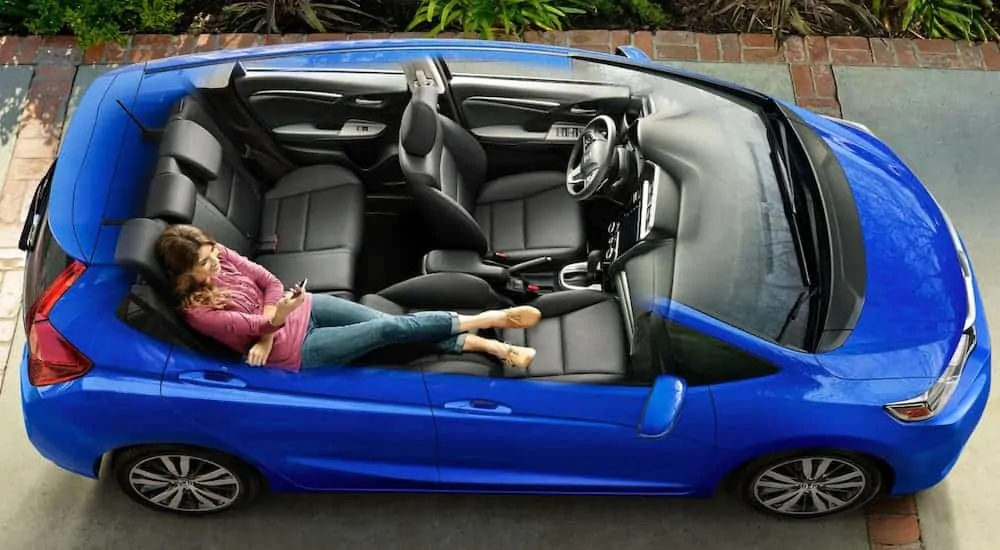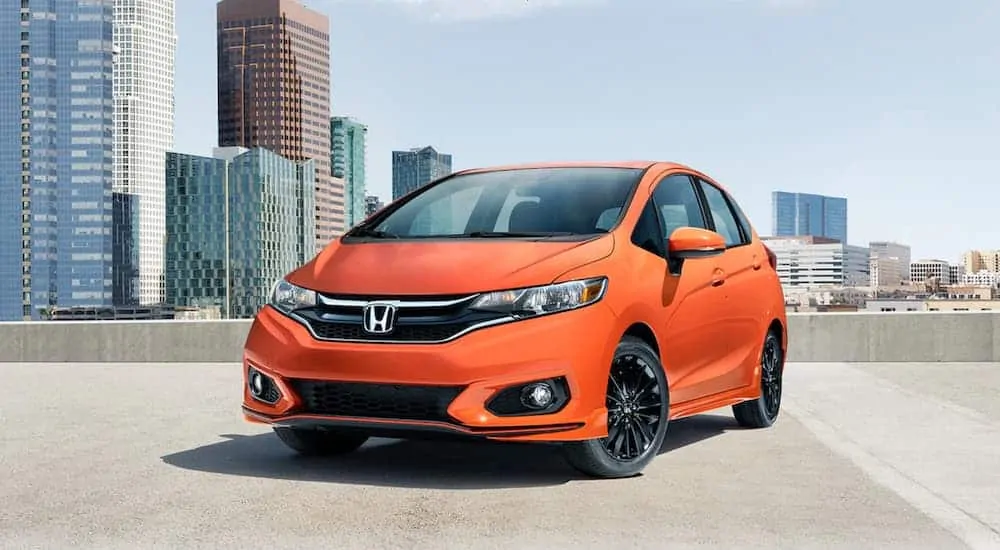Today, cars are constantly increasing in size and cost. The Honda Civic, once renowned as a small and affordable vehicle, now costs over $20,000 (the top trim Touring trim can actually go over $30,000 easily depending on the options chosen) and is larger than some 1990’s Honda Accords. However, the old Honda spirit is not gone––it has merely transferred to the smaller Honda Fit. This little subcompact car comes with the trademark Honda i-VTEC engine and starts at just a hair over $16,000. Whether you are looking for low-cost practical transportation or a fun little car that brings to mind the Hondas of yore, the 2020 Honda Fit is an option well worth considering.
The Honda Fit was first introduced to the American market for the 2007 model year. However, the first generation Honda Fit had been sold in Japan since 2001, so an improved second generation was soon released for the 2009 model year. The 2020 Honda Fit is the latest model year of the third generation, which was first introduced for 2015. However, the 2020 Honda Fit is also likely to mark the final model year of the third generation, as the fourth generation Honda Fit has already been released in Japan and is likely coming to America for the 2021 model year. But the specifications of a potential American market fourth-generation Honda Fit are still unknown as significant changes are usually made from the Japanese market version.
A Roomy and High-Value Interior

From the outside, the 2020 Honda Fit is admittedly not much to look at. But while its blunt wedge shape and somewhat plain styling will not win it many aesthetic awards, they do contribute to an incredibly spacious interior. With almost 40” of headroom and a staggering 52.7 cubic feet of cargo room, the 2020 Honda Fit actually competes with compact SUVs when it comes to interior space and beats the larger 2020 Honda Civic Hatch by a considerable margin. This practicality is further enhanced by the “Magic Seats” in the 2020 Honda Fit. Not only do these seats fold down (in a 60/40 split as on nearly all hatchbacks), they also fold up, giving you the option of fitting tall items upright in the second row.
Another aspect of the 2020 Honda Fit that belies its small size is its excellent crash test ratings. In both government NHTSA testing and in independent IIHS testing, the 2020 Honda Fit achieved top marks in nearly every category, only giving up points on the NHTSA rollover resistance and the IIHS headlight brightness tests. This actually means that the 2020 Honda Fit is safer than many larger but older used vehicles in the same price range––an important aspect to consider when cross-shopping new budget cars against older more upscale cars.
The 2020 Honda Fit is not just practical; it is also quite comfortable and does not lack any major features. Honda made good use of varied materials when designing the 2020 Honda Fit, and the result is an interior that feels just as good as those of the company’s more expensive cars. More importantly, even the base LX trim of the 2020 Honda Fit has all the interior features that you would expect of a modern car––something that is not the case with some of the other subcompacts on the market. The standard features on all trims of the 2020 Honda Fit include cruise control, one-touch turn signals, steering wheel controls, and programmable power-locking doors. While the infotainment system on the base LX trim of the 2020 Honda Fit is somewhat lacking, with only a basic 5” screen and four speakers, all of the other trims all have a very usable standard infotainment system that only includes a 7” high definition touchscreen and six speakers. This upgraded system also fully supports Apple CarPlay, Android Auto, Pandora, and SiriusXM satellite radio, giving you access to all of the entertainment you need to have an enjoyable driving experience.
The higher EX and EX-L trims build on the base features with push-button start and some better interior materials, exterior upgrades such as fog lights and a power sunroof, and a range of modern active safety features. Those safety features include automatic emergency braking, lane keeping assist, adaptive cruise control, and automatic headlights, but unfortunately do not include blind spot monitoring. Still, this package does make for a significantly safer and more relaxing drive. And in contrast to the products from some other manufacturers, these features of the 2020 Honda Fit all come standard with the appropriate trims. The only non-cosmetic options are minor pieces of equipment, such as a remote start system or an auto-dimming mirror with HomeLink. However, if you do want to make your car stand out, then you can easily spend thousands of dollars on factory appearance upgrades.
Mechanics and Performance
While interior design, cargo space, and infotainment are important, the heart of any car is its performance. The 2020 Honda Fit is not a sports car by any stretch of the imagination. However, it is not difficult to argue that it can be a fun car. With a curb weight as low as 2,522 pounds, the 2020 Honda Fit has far better handling and acceleration than you might think. The 2020 Honda Fit is also available with a six-speed manual transmission that has a fairly aggressive gear ratio, allowing you to experience old-school driving in a modern car. However, if a manual is not your speed, the standard CVT does come with paddle shifters on the higher trims, allowing you to control your gear shifting without needing to operate a clutch.
The engine on the 2020 Honda Fit is a naturally-aspirated DOHC 1.5L inline-four. Although this engine does have Honda’s trademark i-VTEC, it redlines at only 6800 rpm, making for a more drivable (if perhaps slightly less fun) experience than some older Honda’s. When paired with the manual transmission, this engine produces 130 horsepower at 6600 rpm and 114 lb-ft of torque at 4600 rpm. However, with the CVT, those numbers drop slightly to 128 horsepower and 113 lb-ft of torque. But in either configuration, the 2020 Honda Fit has a rather decent power to weight ratio, making it one of the best-performing subcompacts on the market.
Unfortunately, the fuel efficiency of the 2020 Honda Fit is not quite as good as you might expect from a car of its size. At 31 MPG combined with the manual transmission and 33 MPG combined with the CVT, the 2020 Honda Fit actually burns slightly more gas than the larger 2020 Honda Civic. But if you really want to save fuel and can live without extra features, then the base LX trim with the CVT somehow gets an excellent 36 MPG combined. The exact reason for such a large difference is unclear, but it makes this trim one of the most fuel-efficient non-hybrid cars on the market.
In the end, the 2020 Honda Fit may not be the best car in any category, but it represents a remarkable blend of practicality and fun that can meet many different needs at an incredibly low price. From the basic LX trim to the engaging Sport trim, to the comfortable EX trim, the 2020 Honda Fit puts a modern twist on the classic Honda spirit and refills the niche that the Honda Civic is increasingly growing out of.





